Hamsters
Hamsters Eat French Fries: A How-To Guide for Safe Feeding
Hungry for tips on feeding your hamster? Discover why French fries may not be the best choice and learn safe alternatives.

Feeding hamsters French fries can be risky because they contain high levels of fat and lack essential nutrients. This could harm their digestive systems as it is not part of their natural diet. It is safer to offer small, occasional portions of plain potatoes as a treat, while monitoring their weight gain and hydration levels.
If you want to know more about safe feeding guidelines, we have tips on proper portions, healthy snack alternatives, monitoring hamster health, and safe preparation techniques.
Key Takeaways
- Offer plain, boiled, or steamed potatoes.
- Limit quantity to prevent digestive issues.
- Avoid seasonings, oils, or salts.
- Opt for fresh fruits and veggies.
- Monitor hamster health and weight closely.
Potential Risks of Feeding French Fries
When considering the potential risks of feeding French fries to hamsters, it's important to understand that these popular human snacks can pose serious health hazards to our tiny furry friends.
The high fat content in French fries far exceeds a hamster's recommended fat intake, making them prone to obesity and related health issues. Additionally, additives like garlic and spices present in French fries can be harmful to hamsters' sensitive digestive systems.
It's essential to note that French fries lack essential nutrients necessary for a hamster's well-being. Excessive consumption of French fries can lead to nutrient deficiencies in hamsters, compromising their overall health.
Unlike their wild counterparts, domestic hamsters don't naturally consume potatoes, making French fries an unnatural and risky choice for feeding. Understanding these risks associated with feeding French fries to hamsters is crucial in ensuring the health and longevity of our beloved pets.
Proper Portions for Hamsters
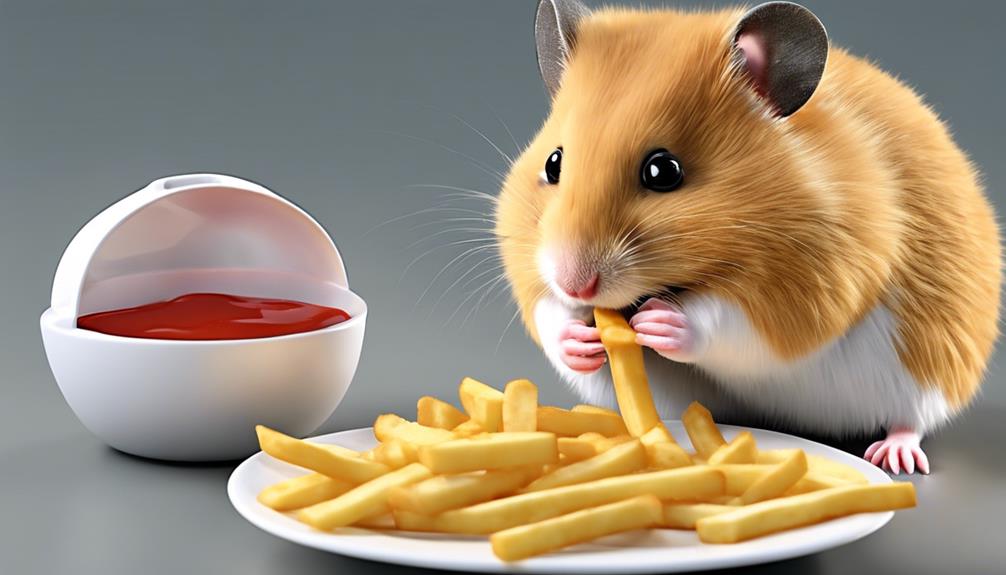
Properly portioning food for hamsters is essential in maintaining their health and well-being. When it comes to feeding hamsters plain, cooked potatoes, it's important to offer only a small portion as an occasional treat.
Limiting the amount of potato given to hamsters is vital to prevent digestive issues that can arise from overconsumption. A quarter teaspoon of mashed potatoes can be a rare treat for these small pets. Plain potatoes can serve as a safer alternative to French fries, but always make sure controlled amounts.
Moderation is key in providing a balanced diet for hamsters, so remember to offer potatoes sparingly and as part of a varied meal plan.
Alternative Healthy Snacks
To provide hamsters with alternative healthy snacks, consider opting for fresh fruits and vegetables like carrots, broccoli, and apples. These options offer a variety of nutrients and are a great way to introduce healthy alternatives to their diet.
Additionally, offering small amounts of fruits such as pears, peaches, and melons as occasional treats can be a source of enjoyment for your furry friend. While fresh fruits and vegetables are crucial, don't forget to include commercial pellets in your hamster's diet to guarantee they receive all the necessary nutrients for a balanced meal plan.
Incorporating fresh Timothy hay into their daily intake can help maintain their digestive health due to its fiber-rich content. Remember, occasional treats like mealworms and boiled eggs can also provide a nutritional boost.
Monitoring Hamster Health
Shifting from discussing alternative nutritious snacks, it is essential to closely observe your hamster's health to safeguard their well-being and detect any potential issues promptly. Monitoring your hamster's health involves keeping an eye on various aspects such as weight, dehydration, activity level, digestive issues, fur quality, energy levels, appetite, and overall health issues. Regular vet check-ups play an important role in guaranteeing your hamster's well-being, especially if they have been indulging in foods like French fries.
| Aspect | Importance |
|---|---|
| Weight | Monitor regularly to prevent excessive weight gain from unhealthy foods. |
| Dehydration | Watch for signs as salt in French fries can lead to dehydration. |
| Activity Level | Observe behavior post-feeding to detect any potential digestive issues. |
| Fur Quality | Be attentive to changes that may indicate underlying health problems. |
| Energy Levels | Notice any fluctuations that could be related to their dietary habits. |
Being attentive to these indicators will help you guarantee your hamster's health is in top shape.
Safe Preparation Techniques
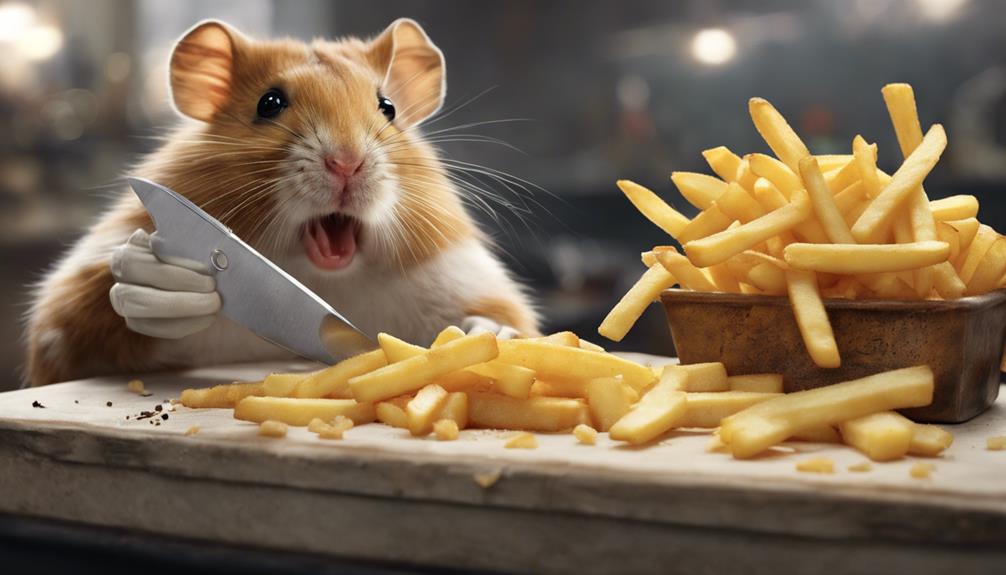
When preparing food for your hamster, it's essential to follow safe techniques to guarantee their well-being and health.
When it comes to feeding potatoes to hamsters, opt for plain, boiled, steamed, or mashed varieties as occasional treats. It's important to avoid adding oil, butter, salt, or any seasonings when preparing potatoes for your furry friend. Plain potatoes offer essential nutrients like vitamin C and niacin without any harmful additives that could jeopardize your hamster's health.
Remember, moderation is key when it comes to feeding potatoes to hamsters to prevent any potential digestive issues. Choosing plain potatoes over French fries ensures that your hamster receives a simple, nutritious treat.
Frequently Asked Questions
How Do You Properly Feed a Hamster?
We carefully offer hamsters plain, cooked potatoes as occasional treats, ensuring no salt, oil, or seasonings are present. Importance is necessary to prevent digestive issues. Cooked potatoes provide essential nutrients like vitamin C and niacin.
How Do I Make My Hamster Safe Food?
We make sure to offer our hamsters safe food by providing plain, cooked options like white or sweet potatoes. Avoiding oils, salts, and seasonings is essential. Moderation is key to preventing digestive issues. Fresh, unprocessed treats can supplement their diet.
What Can I Feed My Hamster if I Run Out of Food?
If we run out of hamster food, we can offer plain cooked potatoes as a temporary option. It's important to avoid French fries or processed foods. Once restocked, focus on a balanced diet. Remember, a vet can offer guidance on emergency feeding options or diet concerns.
How Much Scrambled Egg Can a Hamster Eat?
We advise restricting scrambled egg portions to a small piece once or twice a week for a hamster. It is crucial to provide plain eggs without added salt, butter, or seasonings to guarantee a balanced diet.
Can Hamsters Eat French Fries Safely Like They Can Eat Coconut?
Yes, hamsters can eat French fries safely like they can eat coconut. However, it is important to note that both foods should only be given in small amounts as an occasional treat. While coconut is a healthier option, feeding hamsters coconut should still be done in moderation to ensure their overall well-being.
Conclusion
As we conclude our guide on feeding french fries to hamsters, remember to always prioritize the health and well-being of your furry friends.
While it may be tempting to indulge them with treats, moderation is crucial. Choose healthier snack options and monitor their health closely.
By taking these precautions, you can guarantee that your hamster stays happy and healthy for years to come.
And remember, just because they can eat french fries, doesn't mean they should!
Paul’s love for animals knows no bounds. As a dedicated writer and animal lover, Paul brings a unique perspective to our team. His firsthand experiences with various animals enrich our content and provide valuable insights into their behavior and needs. Whether he’s sharing tips for pet care or shedding light on pressing conservation issues, Paul’s passion for animals shines through in everything he does.
Hamsters
How Hamsters Can Safely Eat Bell Peppers: A Guide
An essential guide on safely feeding bell peppers to hamsters, ensuring their health and enjoyment – discover the key tips here!
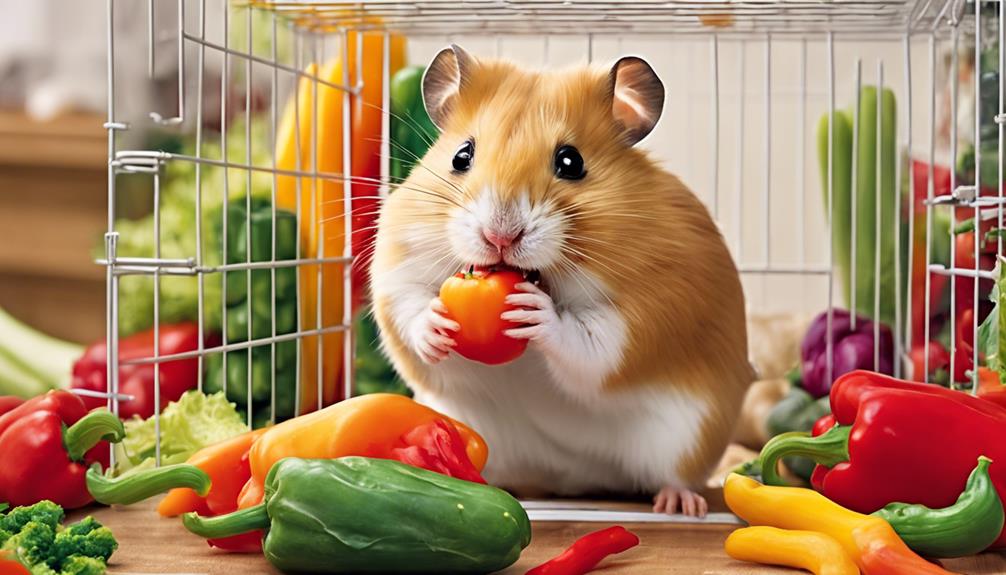
When giving bell peppers to hamsters, it is essential to prioritize their safety and health. We suggest washing the peppers thoroughly to eliminate any pesticides, removing the seeds and stems to prevent choking risks, and cutting them into small, bite-sized pieces for easy eating. Stick to red, yellow, and green sweet peppers as they are safe and nutritious, while avoiding hot or chili peppers.
Remember to offer bell peppers in moderation, monitor for any digestive issues, and remove uneaten portions promptly. By following these guidelines, hamsters can enjoy bell peppers as a healthy treat.
Key Takeaways
- Wash bell peppers thoroughly to remove pesticides before feeding.
- Remove seeds and stem to prevent choking hazards.
- Cut bell peppers into small, bite-sized pieces for easy consumption.
- Offer red, green, or yellow sweet peppers; avoid hot varieties.
- Feed bell peppers in moderation, 2-3 times a week to prevent overconsumption.
Benefits of Bell Peppers for Hamsters
Bell peppers offer numerous health benefits for hamsters, making them a valuable addition to their diet. These vibrant veggies are packed with Vitamin C, crucial for boosting a hamster's immune system. The fiber content in bell peppers supports proper digestion for our furry friends, ensuring their tummies stay happy and healthy. Additionally, the antioxidants found in bell peppers can help reduce the risk of diseases in hamsters, keeping them strong and vibrant.
Moreover, bell peppers contain pantothenic acid, which plays a vital role in the production of healthy blood cells for hamsters. This nutrient is essential for overall well-being and vitality. Furthermore, the iron present in bell peppers can help prevent anemia in hamsters, ensuring they maintain optimal health. By incorporating bell peppers into their diet, hamsters can enjoy a range of benefits that contribute to their overall wellness, from a robust immune system to healthy blood cell production.
Proper Bell Pepper Preparation for Hamsters

When preparing bell peppers for hamsters, it's essential to ensure they're thoroughly washed to remove any pesticides or dirt before feeding them to our furry friends. Washing the bell peppers under running water and scrubbing gently with a brush can help eliminate any harmful substances that may be present on the skin. Additionally, it's crucial to remove the seeds and stem from the bell peppers as they can pose a choking hazard to hamsters.
Cutting the bell peppers into small, bite-sized pieces is also important to make it easier for hamsters to eat and digest. Offering fresh bell peppers instead of cooked or processed ones ensures that hamsters receive the maximum nutritional benefits from this healthy treat. Remember to monitor your hamsters while they eat bell peppers to ensure they're chewing properly and not experiencing any digestive issues.
Safe Bell Pepper Varieties for Hamsters
After ensuring proper preparation of bell peppers for hamsters, selecting safe varieties is crucial for their well-being and health. When considering the best bell pepper options for your furry friend, keep the following in mind:
- Red Bell Pepper: Red sweet peppers are a safe and nutritious choice for hamsters. They're rich in healthy nutrients and provide a tasty treat that your pet will enjoy.
- Green Peppers: Green peppers are also a suitable option for hamsters. They've a milder taste compared to red or yellow peppers, making them a great addition to your hamster's diet.
- Safe Pepper Varieties: Stick to red, yellow, and green sweet peppers as hot or chili peppers can be harmful to hamsters. Ensuring you offer the right type of pepper is essential for your pet's well-being.
- Nutritional Value: Bell peppers have high water content and essential nutrients that can contribute to proper bowel function and overall health for your hamster. Incorporating these safe pepper varieties into your hamster's diet can be beneficial.
Moderation Tips for Feeding Bell Peppers
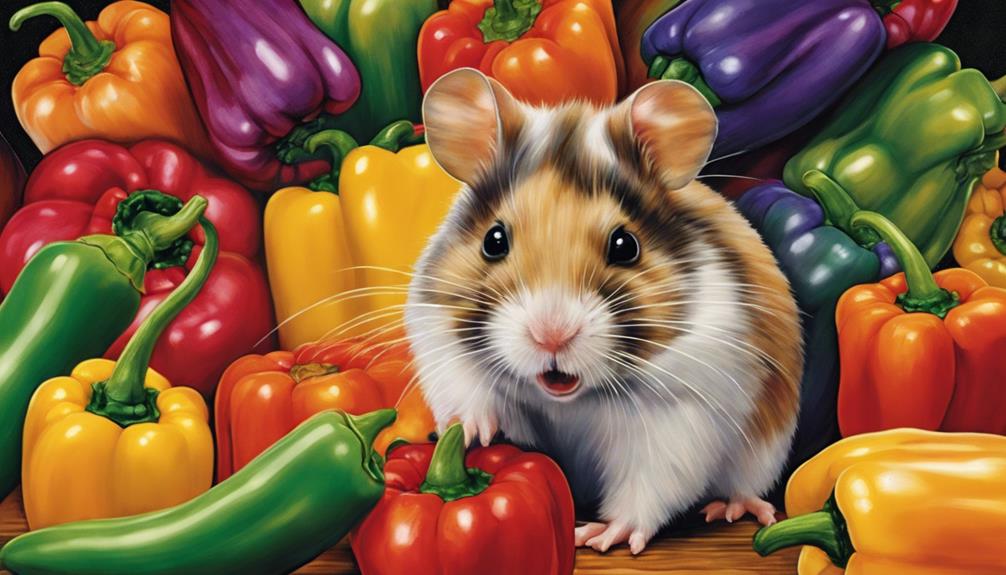
To maintain a healthy diet for your hamster, it's important to offer small slices of bell pepper in moderation, typically 2-3 times a week to prevent overconsumption and digestive issues. When feeding your hamster bell peppers, remember that moderation is key. Both green and red bell peppers can be included in your hamster's diet as a source of essential nutrients.
It's essential to monitor your hamster for any signs of digestive issues like diarrhea or bloating after adding bell peppers to their diet. Additionally, removing any uneaten bell peppers within 12 hours is crucial to prevent spoilage and potential health risks.
Before feeding, ensure that the bell peppers are washed thoroughly to eliminate any pesticides or dirt that may be present. By following these moderation tips and providing bell peppers as a treat in a balanced manner, you can ensure that your hamster remains healthy and content.
Nutritional Guidelines for Hamsters
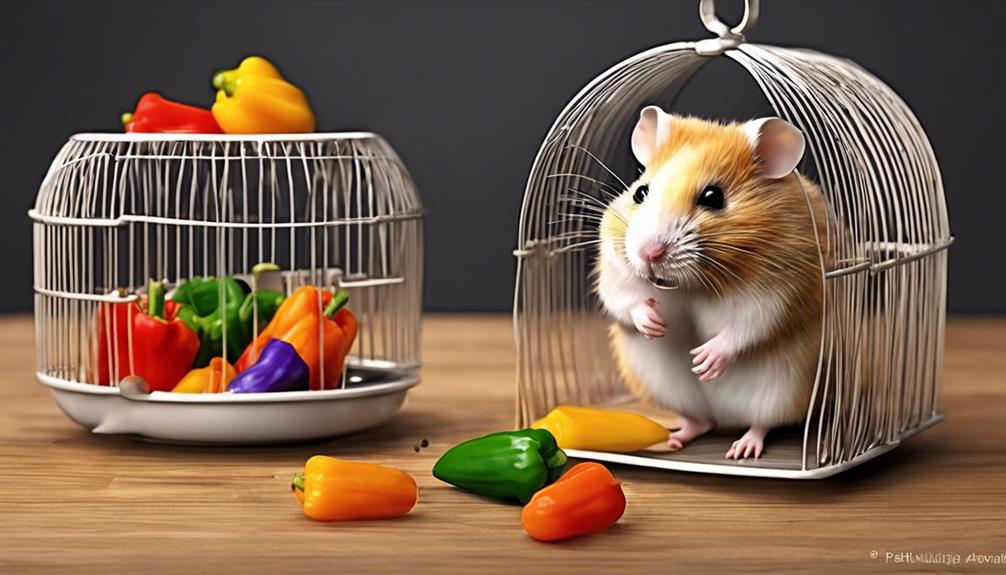
Our hamsters' nutritional requirements can be met by incorporating a diverse range of foods that offer essential vitamins and minerals for their overall well-being. When considering what to feed your furry friend, keep in mind the following guidelines:
- Vitamin C: Bell peppers are a great source of vitamin C, crucial for supporting a hamster's immune system and overall health.
- Vitamin A: This nutrient, found in bell peppers, plays a vital role in promoting vision and skin health in hamsters.
- Potassium: Bell peppers help maintain a hamster's blood pressure balance due to their potassium content.
- Dietary Fiber: The skin of bell peppers provides dietary fiber, aiding in digestion and ensuring your hamster's gastrointestinal health.
Frequently Asked Questions
What Foods Are Poisonous to Hamsters?
We've to be cautious about what we feed our hamsters. Foods like garlic, onions, chocolate, apple and cherry seeds, and citrus fruits can be poisonous to them. Even small amounts of these items can lead to serious health problems or be fatal.
It's crucial to know what foods are harmful to hamsters and always seek advice from a vet or reliable sources to ensure their diet is safe. Being mindful of potential dangers can help keep our furry friends healthy and happy.
Are Bell Peppers Safe for Animals?
Bell peppers are safe for animals to consume in moderation. They're low in fat and high in fiber, providing essential vitamins and minerals. Animals may enjoy the taste and texture of bell peppers as a healthy treat.
It's crucial to monitor animals for any adverse reactions after feeding them bell peppers.
What Daily Vegetable Can I Give My Hamster?
We can give our hamsters a variety of vegetables, but bell peppers are a fantastic daily option. These colorful veggies provide essential nutrients like Vitamin C and fiber.
However, remember moderation is key – offer small amounts a few times a week to prevent overfeeding. Ensure to wash the bell peppers thoroughly to remove any pesticides or dirt before feeding them to our furry friends.
Always monitor for any allergies or digestive issues when introducing new foods.
Why Can't Hamsters Eat Onions?
We can't feed hamsters onions because they contain compounds that harm a hamster's red blood cells. Onions can cause symptoms like weakness, lethargy, and even organ damage in these small pets.
It's crucial to keep all parts of the onion, including the bulb, leaves, and stems, away from hamsters to prevent poisoning. Always prioritize your hamster's health by avoiding onions and onion-containing foods in their diet.
Can the Guidelines for Feeding Chickens Beet Greens Also Apply to Feeding Hamsters Bell Peppers?
When considering how to feed chickens beet greens, it’s important to note that while chickens can safely consume beet greens, the same cannot be said for hamsters and bell peppers. Be sure to research the appropriate diet for your hamster and avoid feeding them foods like bell peppers that may be harmful.
Conclusion
In conclusion, bell peppers can be a nutritious and tasty treat for your hamster when fed in moderation and prepared properly. Remember to choose safe varieties, remove seeds and stems, and always consider your hamster's individual dietary needs.
'The proof is in the pudding,' so observe your furry friend's reaction to bell peppers and adjust accordingly. With the right approach, your hamster can enjoy the benefits of this colorful vegetable as part of a balanced diet.
Laura is a versatile writer and editor whose passion for animals shines through in her work. With a keen understanding of language and a love for storytelling, Laura crafts compelling narratives that captivate our audience and inspire action regarding animal welfare. Whether she’s delving into the latest research or sharing heartwarming stories of animal companionship, Laura’s work will leave a lasting impression on all who read it.
Hamsters
How Hamsters Can Safely Have Orange Treats
Munching on oranges can be a healthy treat for hamsters, but there's a catch – find out how to ensure their safety and well-being!
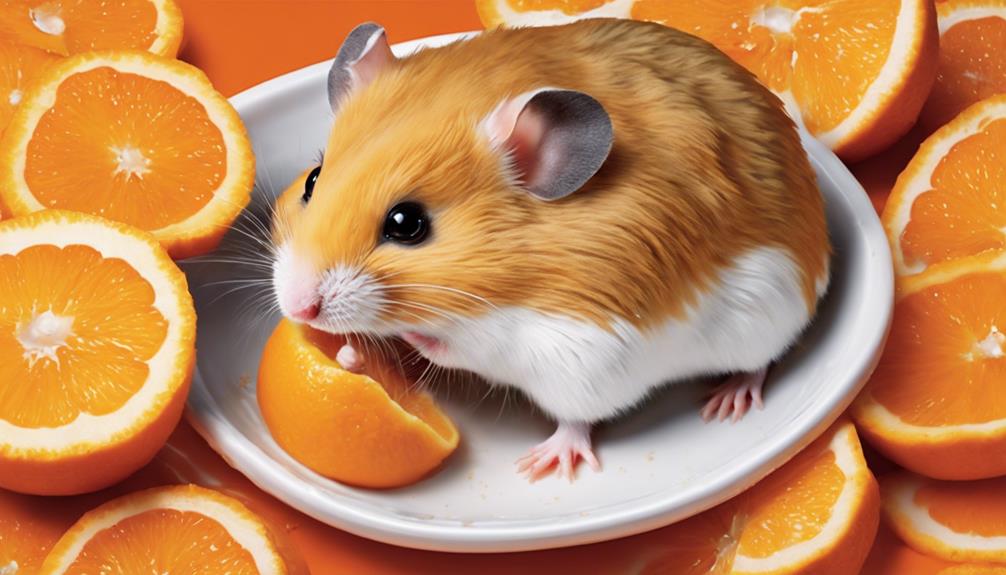
When feeding hamsters orange treats, it is important to be mindful of the potential impact on their health and digestion. While oranges provide essential vitamin C and fiber, their high acidity means moderation is crucial. To safely give oranges to hamsters, always remove seeds and peel, wash them thoroughly, and cut into small pieces to prevent choking. Keep a close eye on them for any adverse reactions such as stomach upset, and consider safer alternatives like apples or blueberries.
Remember, a balanced diet is vital for our hamsters' wellbeing.
Key Takeaways
- Choose safer alternatives like apples, carrots, blueberries, and strawberries for hamsters.
- Remove peel, seeds, and wash thoroughly before cutting oranges into small, bite-sized pieces.
- Monitor hamsters closely for signs of tummy distress like diarrhea after introducing oranges.
- Provide small portions of treats to prevent digestive issues and offer nutritional variety.
- Seek veterinary consultation if hamsters show adverse reactions to oranges for prompt care.
Benefits of Oranges for Hamsters
Oranges offer valuable benefits for hamsters, enriching their diet with essential vitamin C and natural sugars to support their immune system and provide a tasty treat. Vitamin C is crucial for hamsters as they can't produce it themselves, making oranges a great source to boost their immune system. The natural sugars in oranges can serve as a delightful occasional treat for hamsters, adding variety to their diet. Additionally, the fiber content in oranges can aid in digestion for these small creatures, promoting overall gut health.
When considering incorporating oranges into a hamster's diet, moderation is key. While oranges can be a healthy addition, they should be given in small, occasional pieces to prevent any digestive issues. Balancing treats like oranges with their regular pellet diet ensures that hamsters receive the necessary nutrients without overindulging. By offering oranges in moderation, hamsters can enjoy the benefits without compromising their overall well-being.
Safe Serving Sizes for Hamsters
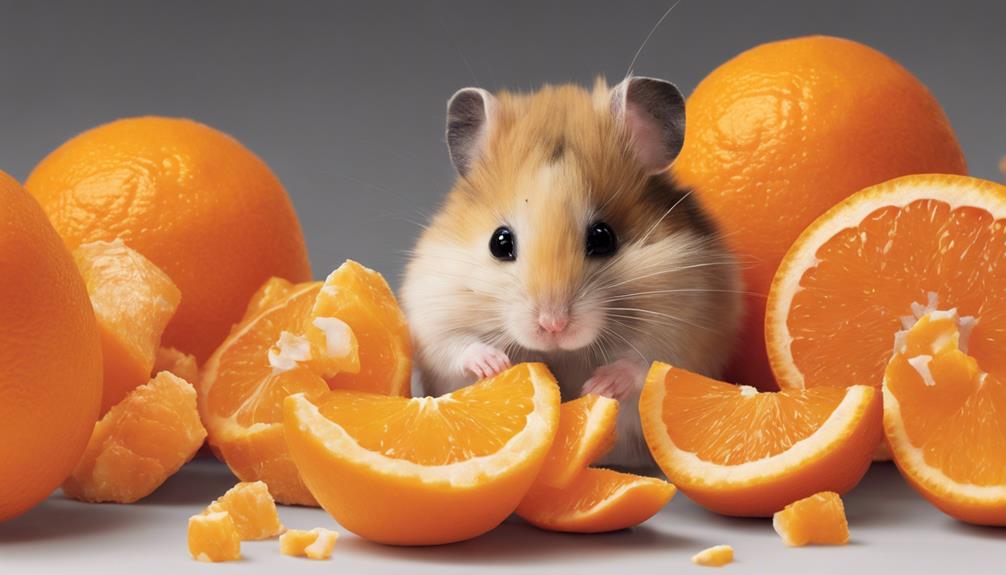
To ensure the well-being of your hamster, it is vital to understand the appropriate portion sizes when offering them treats. Hamsters love fruits, but when it comes to oranges, it's best to avoid them due to their high acidity that can upset your pet's tummy. Opt for safer alternatives like apples, carrots, blueberries, and strawberries to keep your hamster healthy and happy. When it comes to serving sizes, it's crucial to remember that hamsters are tiny creatures with small stomachs. Here's a simple guide to help you navigate the right portion sizes for your furry friend:
| Fruit Type | Serving Size |
|---|---|
| Apples | 1 small slice |
| Carrots | 1 baby carrot |
| Blueberries | 2-3 berries |
| Strawberries | 1 whole berry |
Preparing Oranges for Hamsters
When preparing oranges for hamsters, it's essential to thoroughly remove the peel and seeds to ensure their safety and well-being. Always wash the oranges thoroughly to eliminate any pesticides or residues that could be harmful to your furry friend.
Cut the oranges into small, bite-sized pieces to prevent choking hazards for hamsters. Due to the high acidity of oranges, it's crucial to limit these treats to occasional small portions.
Keep a close eye on your hamster and monitor for any signs of digestive issues after introducing oranges into their diet. By following these steps and preparing fresh oranges in the right way, you can offer your hamster a tasty and healthy treat that they'll enjoy.
Monitoring Hamster Reactions to Oranges
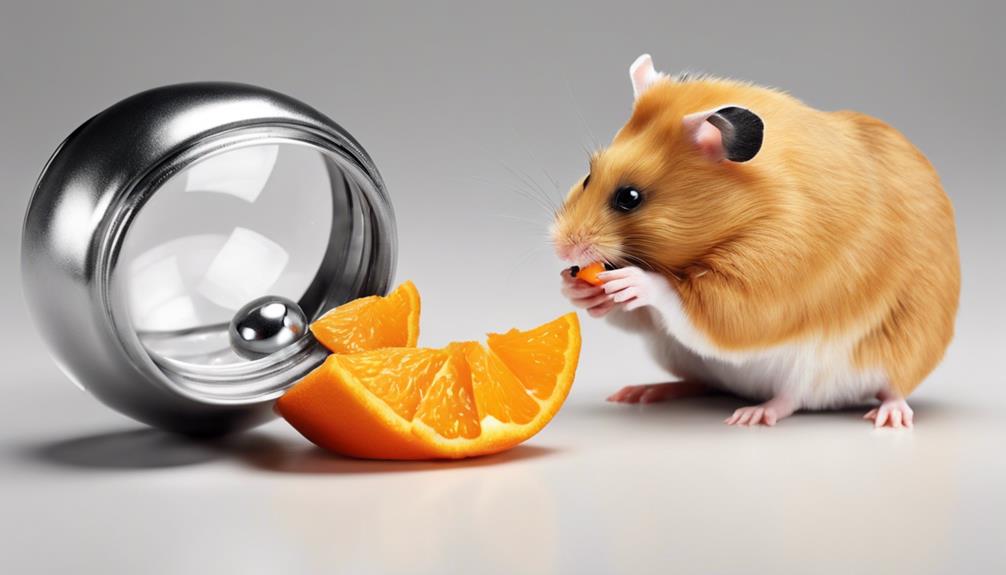
After properly preparing oranges for hamsters, it's important to closely monitor their reactions to the new treat to ensure their well-being and health. When introducing oranges as an occasional treat, observe any signs of tummy distress such as diarrhea, which could indicate digestive issues. Keep an eye on your hamster's appetite, behavior, and droppings for any changes after feeding oranges.
If you notice adverse effects or behavior changes, promptly remove oranges from their diet. It's crucial to document how your hamster responds to oranges to determine if they can safely enjoy this food. In case of any concerning symptoms, such as persistent digestive problems or unusual behavior, seek immediate veterinarian consultation.
Monitoring your hamster's reactions to oranges is essential in maintaining their well-being and ensuring that they can safely incorporate new foods into their diet.
Alternative Treat Options for Hamsters

Consider providing hamsters with a variety of safe treat options to add nutritional variety to their diet. Along with hamster mix, fresh fruits, and veggies, you can offer small pieces of unsweetened whole grain bread or plain cereals as treats. These options are safe for hamsters and can be given in moderation to prevent dietary issues.
For protein sources, consider occasional treats like cooked eggs or mealworms, which can help meet their dietary needs. Dwarf Hamsters, in particular, benefit from a diverse diet that includes different types of treats.
It's crucial to avoid sugary foods like sweets, chocolate, or high-sugar treats, as these can lead to health problems for hamsters. By including a mix of safe and nutritious treats in their diet, you can keep your hamster happy and healthy while providing them with a range of flavors and textures to enjoy.
Frequently Asked Questions
Can Hamsters Have Orange Treats?
We need to remember that hamsters shouldn't have orange treats or any citrus fruits. These fruits are too acidic and can lead to tummy issues and diarrhea in hamsters.
It's crucial to avoid giving them oranges, tangerines, lemons, or grapefruits as treats. Always put your hamster's digestive health first by steering clear of citrus fruits in their diet.
Prioritize their well-being and choose safer treat options for your furry friend.
What Treats Can Hamsters Eat?
We can offer hamsters a variety of treats such as sugarless breakfast cereals, greens, seeds, carrots, apples, raisins, peas, pepper, and cucumbers in moderation.
However, it's crucial to avoid dried fruits and vegetables high in sugar.
While these treats can be enjoyable, they should complement a balanced pelleted diet to ensure hamsters receive adequate nutrition.
Can I Feed My Hamster Sweets?
We should avoid feeding hamsters sweets to prevent health issues like obesity and digestive upset. Chocolate is toxic to them. Stick to nutritious treats like whole grain bread or small pieces of fruit.
Consult a vet before introducing new foods to your hamster. Remember, their well-being is our top priority. Let's ensure our furry friends stay healthy and happy by making smart choices when it comes to their diet.
How Often Should You Give Hamsters Treats?
We should give hamsters treats occasionally to maintain their balanced diet. It's essential to offer treats in small amounts to prevent digestive issues and obesity.
Monitoring our hamster's weight and overall health can help determine the frequency of treats. Typically, giving treats once or twice a week is sufficient for most hamsters.
Limiting treats is crucial to avoid health problems and ensure our furry friends stay happy and healthy.
Can I Feed My Hamster French Fries if They Can Safely Have Orange Treats?
Feeding hamsters french fries safely is not advisable, even if they can safely have orange treats. While it’s tempting to give your pet a taste of your snack, hamsters have specific dietary requirements. Stick to approved fruits and veggies for hamsters, and avoid giving them human food, such as french fries.
Conclusion
In conclusion, incorporating oranges into a hamster's diet can provide a tasty and nutritious treat. Remember to offer oranges in moderation and monitor your hamster's reaction closely.
By following safe serving sizes and properly preparing the fruit, you can ensure your furry friend enjoys this citrusy snack without any issues.
Remember, a happy hamster is as content as a clam in a cozy shell.
Laura is a versatile writer and editor whose passion for animals shines through in her work. With a keen understanding of language and a love for storytelling, Laura crafts compelling narratives that captivate our audience and inspire action regarding animal welfare. Whether she’s delving into the latest research or sharing heartwarming stories of animal companionship, Laura’s work will leave a lasting impression on all who read it.
Hamsters
How Hamsters Can Safely Eat Bell Peppers
Yearning to discover how hamsters can safely enjoy bell peppers without risking their health? Dive into our guide for essential tips and insights!
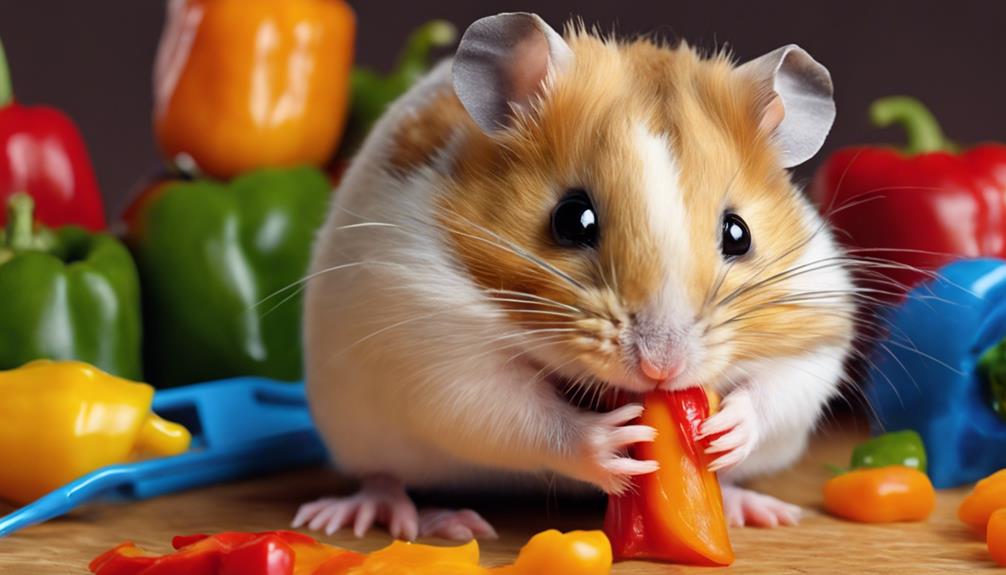
When feeding hamsters bell peppers, it is crucial to properly prepare and manage portion sizes for their health. Cut the bell peppers correctly, removing seeds and white parts, and chop into small pieces to prevent overeating. Give in moderation along with a well-rounded diet and make sure to wash thoroughly to remove any pesticides or dirt. Keep in mind, moderation is essential to prevent digestive problems, so follow recommended portion sizes and watch for signs of discomfort.
If you want to learn more about the benefits of bell peppers and potential risks, we've got you covered.
Key Takeaways
- Slice bell peppers into small, seedless chunks.
- Wash thoroughly to remove dirt and pesticides.
- Offer in moderation to prevent digestive issues.
- Monitor for any signs of distress or allergies.
- Provide a variety of colors for diverse nutrients.
Benefits of Bell Peppers for Hamsters
Bell peppers provide hamsters with essential vitamins A and C, ensuring their well-being and strengthening their immune system. These vibrant veggies aren't only delicious but also beneficial for a hamster's digestive system. The high fiber content in bell peppers supports digestion and promotes regular bowel movements in hamsters.
Moreover, the antioxidants present in bell peppers can enhance a hamster's immune system, decreasing the likelihood of illnesses. Including bell peppers in moderation in a hamster's diet supplies potassium and fiber, which are crucial for overall health and vitality.
Safe Preparation Methods

When preparing bell peppers for hamsters, make sure to wash them thoroughly under running water to eliminate any pesticides or dirt present on the surface. Here are some safe preparation methods to consider:
- Slice Bell Peppers Appropriately: Cut the bell peppers into small, bite-sized pieces for easy consumption by hamsters.
- Remove Seeds and White Parts: Eliminate the seeds and the white inner parts of the bell peppers to prevent choking hazards.
- Cut into Small Chunks: Ensure the bell peppers are cut into small chunks similar in size to two raisins to avoid overfeeding.
- Moderation is Key: Offer bell peppers to your hamster 2-3 times a week in moderation alongside a balanced diet to promote a proper bowel movement and prevent any risks associated with feeding bell peppers.
Recommended Bell Pepper Portions
To guarantee your hamster's well-being and health, it is important to carefully consider the recommended portions of bell peppers for their diet. When it comes to feeding bell peppers to your furry friend, moderation is key. Bell peppers might seem like a healthy snack, but they contain high water content that can lead to digestive issues if overfed. To prevent problems like diarrhea or upset stomachs, offer a piece of bell pepper approximately as long as the hamster's head. This portion size helps control their intake while still providing a tasty treat.
Here is a simple guide to help you understand how much bell pepper your hamster can safely enjoy:
| Type of Bell Pepper | Recommended Portion |
|---|---|
| Red Bell Pepper | Small piece |
| Green Bell Pepper | Small piece |
Types of Bell Peppers to Offer

For a well-rounded diet, consider providing a variety of colored bell peppers to your hamster. Here are the types of bell peppers to offer for your furry friend:
- Green Peppers: Green bell peppers are crunchy and slightly tangy, offering a revitalizing crunch to your hamster's diet. They contain a good amount of Vitamin C, crucial for your hamster's overall health.
- Red Bell Peppers: Sweeter and more flavorful than their green counterparts, red bell peppers are brimming with Vitamin C, making them a delicious and nutritious addition to your hamster's meals.
- Yellow Bell Peppers: Yellow bell peppers have a gentler flavor compared to red ones, adding a different taste profile to your hamster's palate. They also contribute to the colorful mix of nutrients your hamster needs.
- Orange Bell Peppers: With a slightly sweet taste, orange bell peppers provide a variety of nutrients and minerals, enhancing the diversity of your hamster's diet. Offering a mix of colors guarantees your hamster receives a range of vitamins and minerals for maximum health benefits.
Potential Risks to Consider

Considering the potential risks associated with consuming bell peppers, it's important to be mindful of certain factors when incorporating them into a hamster's diet.
Bell peppers have a high water content, so they should be fed in moderation to prevent diarrhea and upset stomach in hamsters. Some hamsters may be allergic to bell peppers, which can lead to adverse reactions such as vomiting or stomach aches.
Due to bell peppers being relatively high in phosphorus and low in calcium, serving them in small amounts is pivotal to avoid diet imbalances. When introducing any new food like bell peppers, it's crucial to monitor hamsters for signs of distress or digestive issues.
While bell peppers are generally safe for hamsters, overfeeding can be harmful, potentially causing dehydration and digestive discomfort. Hence, it's advisable to make sure that bell peppers are served in moderation to keep them safe and beneficial for hamsters.
Frequently Asked Questions
What Foods Are Poisonous to Hamsters?
Some foods poisonous to hamsters include garlic, onions causing anemia, chocolate with caffeine, raw beans, potatoes with harmful substances, almonds containing cyanide traces, and citrus fruits high in acidity. These items should be avoided to keep hamsters safe.
Are Bell Peppers Safe for Animals?
Yes, bell peppers are safe for animals. They contain essential nutrients like fiber and vitamins. Moderation is important to prevent health issues. Thoroughly washing and removing seeds before feeding is essential. Remember, too much can lead to problems.
What Fruits Are Not Good for Hamsters?
Certain fruits like grapes, citrus fruits, avocado, cherries with pits, and rhubarb are not recommended for hamsters due to sugar content, acidity, toxicity, cyanide in pits, and oxalic acid. It's crucial to avoid these for hamster safety.
Why Can't Hamsters Eat Garlic?
Garlic is harmful to hamsters due to compounds causing oxidative damage, potentially leading to anemia, digestive issues, and impaired oxygen transport. To keep our furry friends safe, garlic should be strictly avoided in their diet.
Can Bell Peppers and Zucchini be Part of a Hamster’s Safe Diet?
Yes, hamsters eating zucchini safely and bell peppers is acceptable. These veggies are high in nutrients and can be a part of a balanced hamster diet. However, remember to feed them in moderation and remove any uneaten portions to prevent spoilage. Always consult a vet for dietary advice.
Conclusion
To sum up, bell peppers can make a nutritious addition to a hamster's diet when offered in moderation and prepared safely. By following the recommended portion sizes and choosing the right type of bell peppers, you can provide your furry friend with a tasty and healthy treat.
Remember to always monitor your hamster's reaction to new foods and consult with a veterinarian if you have any concerns. Your hamster will thank you for the delicious and nutritious snack!
Paul’s love for animals knows no bounds. As a dedicated writer and animal lover, Paul brings a unique perspective to our team. His firsthand experiences with various animals enrich our content and provide valuable insights into their behavior and needs. Whether he’s sharing tips for pet care or shedding light on pressing conservation issues, Paul’s passion for animals shines through in everything he does.
-

 Vetted2 months ago
Vetted2 months ago15 Best Cat Foods for Managing Hyperthyroidism – Vet Approved and Feline Friendly
-

 Vetted2 months ago
Vetted2 months ago15 Best Dog Foods for Kidney Disease – Expert Recommendations for Your Pet's Health
-

 Vetted2 months ago
Vetted2 months ago15 Best Fresh Dog Food Delivery Services for Your Pup's Health and Happiness
-

 Animal Facts2 months ago
Animal Facts2 months agoSpring Animals: A Guide to Seasonal Wildlife
-
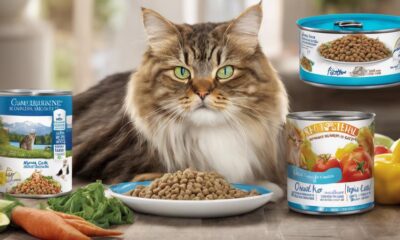
 Vetted2 months ago
Vetted2 months ago15 Best Wet Cat Foods for Older Cats to Keep Them Healthy and Happy
-

 Cats1 month ago
Cats1 month agoCat Weight Chart by Age: Kitten to Senior in Lbs
-

 Cats1 week ago
Cats1 week agoTop 5 Cat Breeders in Arkansas: A Guide
-

 Vetted2 months ago
Vetted2 months ago14 Best Homemade Dog Food Recipes Your Pup Will Love – Vet Approved & Nutritious





















